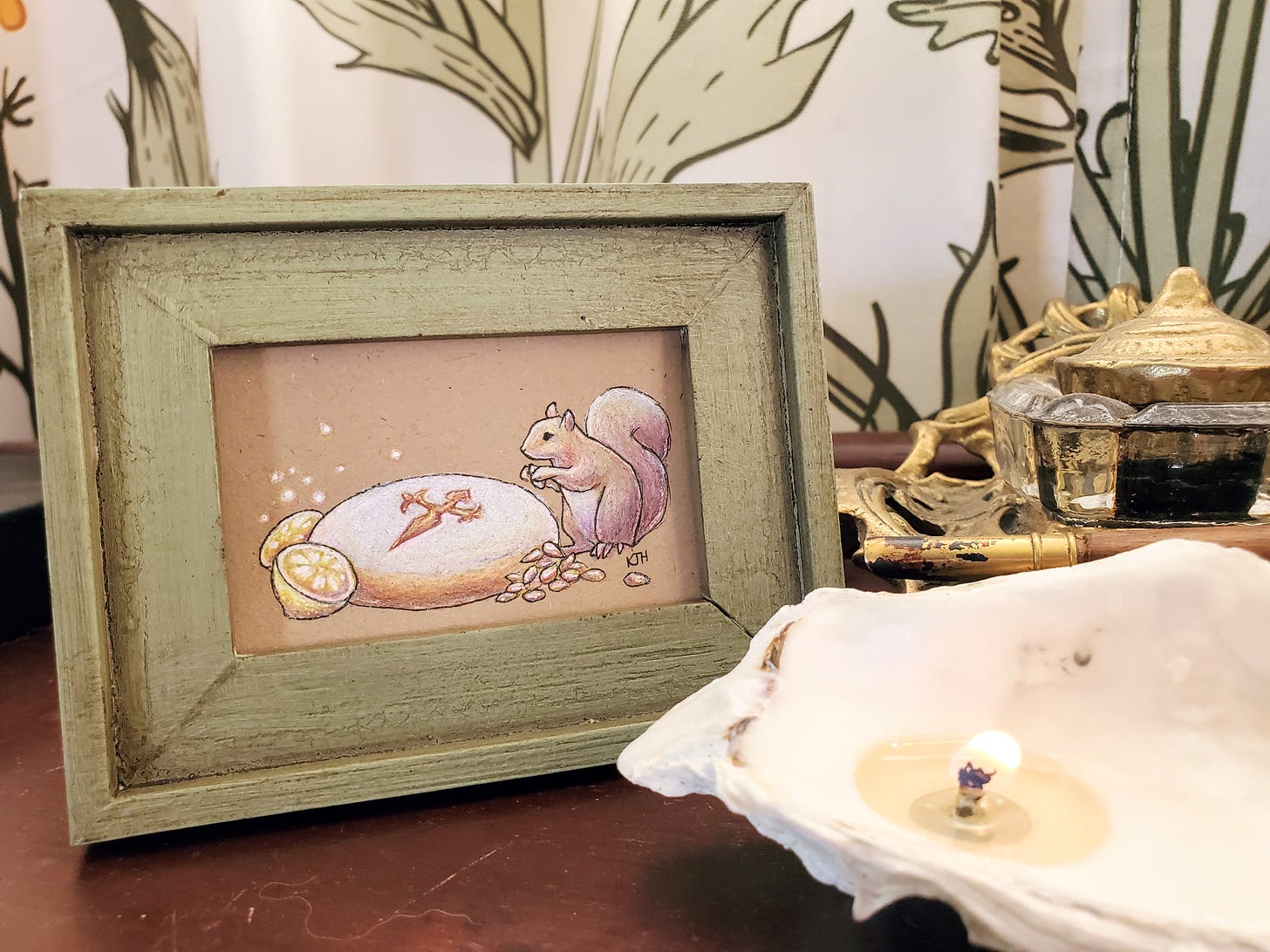July to whom, the Dog Star in her train, St. James gives Oysters and St. Swithun Rain
July 25: St. James' Day: Oyster Shell Votives | Tarta de Santiago Recipe | Paper Scene | Wildroot Blessing
James the Great (son of Zebedee & brother of the Apostle John) was one of the Twelve Apostles. James & John were the first disciples to follow Jesus, and they were also present at the Transfiguration. Herod Agrippa I executed James in 44 AD, and we celebrate his feast day on July 25.
This beautiful summertime festival, settled deeply into the “dog days” of summer, is a welcome punctuation in these often hot, dry days. St. James’ Day brings James to us, of course - and accompanying his memory, seaside breezes and fresh citrus and candlelit summer nights. It’s a holiday that so beautifully illustrates the liturgical calendar’s knack for traveling far & wide, grafting regional customs into its lineage of tradition and letting those regional customs reflect back into its canon of holiday celebration.
St. James, in particular, was beloved by Spain. According to legend (from the 12th century Historia Compostelana), James preached the gospel in both the Holy Land and in Spain:
After his martyrdom, stories say that James’ disciples brought his remains back to Galicia (on the Northwest coast of Spain). A storm hit their ship, and James’ body was lost; when it was recovered, it was covered in scallop shells.
Another legend says that a horse, spooked by the arrival of the ship bearing James’ body, plunged into the sea. Miraculously, the horse & rider were saved, emerging from the water covered in shells.
According to tradition, James’ remains were finally buried at the site of what became the cathedral of Santiago de Compostela (Santiago is Spanish for “St. James”). When this became a popular pilgrimage site, pilgrims would bring back with them a scallop shell as proof of their journey.
So, shells eventually became the symbol of pilgrimage, referring to both the pilgrimages taken to particular holy sites, as well as the spiritual journey of humanity: “These all died in faith, not having received the promises, but having seen them afar off, and were persuaded of them, and embraced them, and confessed that they were strangers and pilgrims on the earth” (Hebrews 11:13 KJV).
These legends of St. James’ association with shells spread far and wide.
In England, the oyster harvest would begin around St. James’ Day (possibly “Old” St. James’ Day)1; kids gathered discarded shells – symbolic of St. James – and built grottos with the shells, tucking flowers, glass, ribbons, moss, etc. among them. They would place a lit candle inside, asking for donations to tend the light.
“In my youth, on or near St. James's Day, many a time have I had a shell thrust at me by a child, saying ‘Please remember the Grotto,’ which consisted of a hollow hivelike construction of oyster shells, with a lighted candle inside, and on the pavement in front was usually a small garden of seaweed and flowers.
“I often wondered how many of them knew that in the XIII. Century a pilgrimage to St. James's Shrine at Compostella was a great and holy feast. The pilgrim wore a shell (scallop) in his hat to advertise the fact that he had accomplished it. Afterwards shell shrines, with lighted candles and flowers in front, were erected in the streets on St. James's Day, and alms were freely given by sailors and travellers.”
Letter to the editor from L.J. Wickes, Baxter Society Quarterly Journal, Volume 4, 1924
“In the grotto formed of oyster-shells and lighted with a votive candle, to which on old St. James's Day the passer-by was earnestly entreated to contribute by cries of ‘please remember the grotto,’ we have a memorial both of the old regulation about oysters and of the world-renowned shrine of St. James at Compatella.”
All the Year Round: A Weekly Journal Conducted by Charles Dickens · Volume 61, 1887
“On St. James's Day (July 25, old style) oysters came in in London; and there is a popular notion that whoever eats oysters on that day will never want money for the rest of the year… The diligent antiquary, Mr. Thoms, considers that in the grotto formed of oyster-shells and lighted with a votive candle, to which, on old St. James's Day (August 5), the passer-by is entreated to contribute, by cries of ‘Pray remember the grotto,’ we have a memorial of the world-renowned shrine of St. James at Compostella, which may have been formerly erected on the anniversary of St. James by poor persons, as an invitation to the pious who could not visit Compostella to show their reverence to the saint by alms-giving to their needy brethren. Oysters are allowed to be sold in London (which city, by the way, levied a tax of 2d. on every person going and returning by the river Thames on pilgrimage to the shrine of St. James) after St. James's Day.
John Timbs, Things Not Generally Known, Familiarly Explained: A Book for Old and Young (1857)
Oyster Shell Votives
Last year, for St. James’ Day, we got together with friends to bring some of these older traditions to life - with swimming, traditional meals, and candlelit oyster shells!



One friend went to her local seafood restaurant and asked if she could collect the discarded oyster shells (just like kiddos from yesteryear used to do); she cleaned the shells, and we poured wax into them to make small votive candles. A miniature nod to the oyster shell grottos of merry England!
To create your own oyster-shell candles:
Melt the wax of your choice in a double-boiler (a suitable dish or pitcher inside a pot of boiling water). We used soy wax, but beeswax would be lovely!
After the wax has melted and reached temperature, add in some essential oils if you'd like.
Affix a wick to the bottom of an oyster shell; this can be tricky, since they come in all shapes and sizes, and some aren't terribly deep. Try to find the deepest spot to place your wick.
Poor the wax in to the shell. Voila: a St. James votive!
Tarta de Santiago
Enjoying a Tarta de Santiago (Spanish for "Cake of St. James") is a quintessential way to celebrate the Feast of St. James! This delicious almond cake dates back to the Middle Ages, though the earliest written reference hails from 1577 (under the name Torta Real, or "royal cake," at the time).
A hallmark of the Tarta de Santiago is its decoration: an imprint of the Cross of St. James; legends surrounding the origin of this cross shape tell of St. James' appearance at the Battle of Clavijo, in answer to the Galicians' prayers for victory.


Here’s a printable recipe for you to experiment with!
St. James Oyster Shell Grotto - Paper Scene
Inspired by the vision of twinkling oyster shell grottos lighting up a summer London night centuries ago, I made this whimsical little paper scene!



Pilgrim-rabbit has arrives at the oyster-shell grotto to celebrate St. James’ feast: he can "light" a candle in the grotto, don his scallop-shell pilgrimage collar, and decorate the grotto with bundles of St. James' Wort and a sign (traditional of these old grottos).
If you have a battery-operated candle, put it behind the grotto to “light” the paper candle!
I’ve tucked a few emblematic details into this little set:
St. James’ Wort: This plant, also known as ragwort, grows along the Camino de Santiago. It was used by Medieval pilgrims to treat ailments from so much walking.
Scallop shell collar: When the cathedral at Santiago de Compostela – where tradition says St. James’ remains are buried - became a popular pilgrimage site, pilgrims would bring back with them a scallop shell as proof of their journey.
If you’d like to enjoy this whimsical scene at home, it’s available to our paid subscriber community in the Scriptorium, and it’s available on Etsy, too:
Blessing
I’m so thrilled and humbled to be able to offer this blessing, written by my soul-ful friend & anam cara,
- “A Blessing for the Feast of Saint James.”After the blessing, a downloadable PDF is available so that you can print it out and ponder it year after year.
"A Blessing for the Feast of Saint James" by S.E. Reid
O God of Sea
who hid the scallop
and the oyster
and the humble clam
within their shells,
draw me out
and shield me
on this pilgrim journey.
O God of Stone
whose good arms are covered
in barnacles
and tender seaweed
and sea-snail spirals,
hang the symbol of pilgrimage
around my neck
and lead me on.
O God of Sky,
of tempest over the waves
of calm in every storm,
and the fire in the hearts
of each beloved Son of Thunder:
bless to me
this feast of Saint James,
and be to me both
the sheltering grotto
and the light
flickering
within.Wishing you & yours a beautiful St. James’ Day…and hoping that as we remember St. James’ devotion, we find “both / the sheltering grotto / and the light / flickering / within.”
Blessings,
Kristin
The research is unclear about the timing of London’s shell grottoes and the connection to St. James; by the Old Style calendar, oyster season would have begun on Old St. James’ Day, in August.











This is so beautiful, and I love the idea of him being covered in shells when his body was recovered.